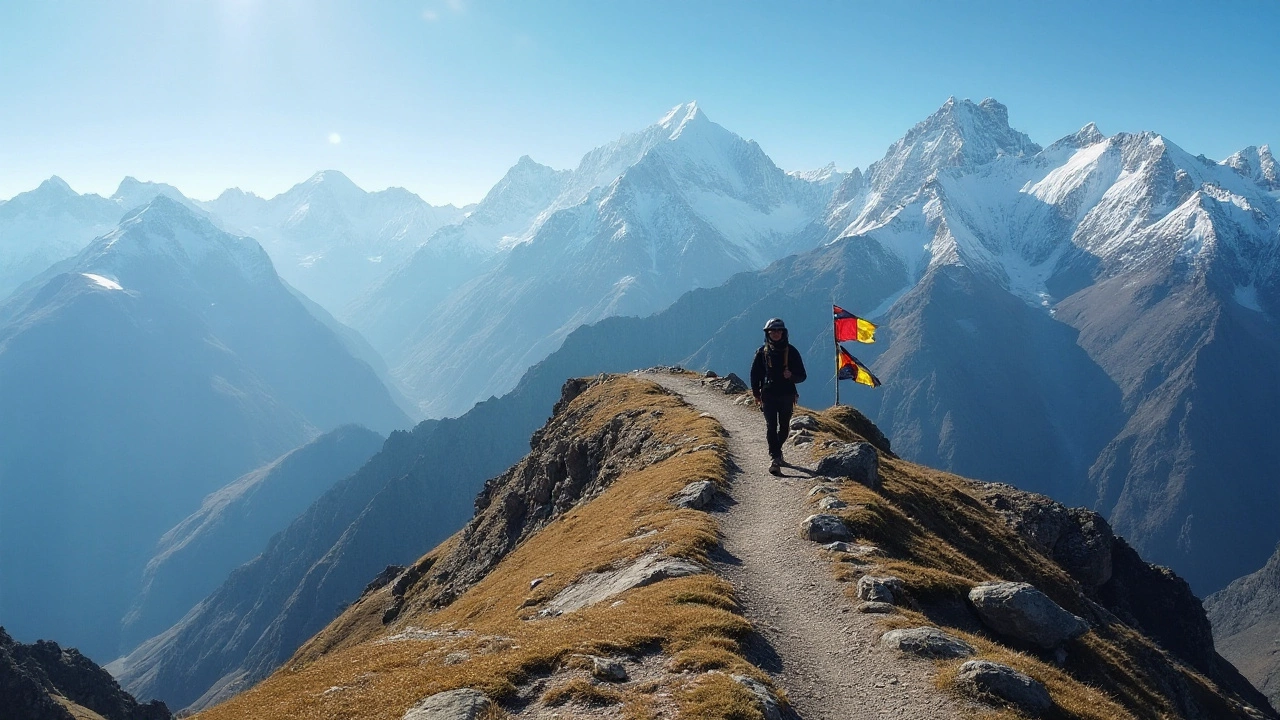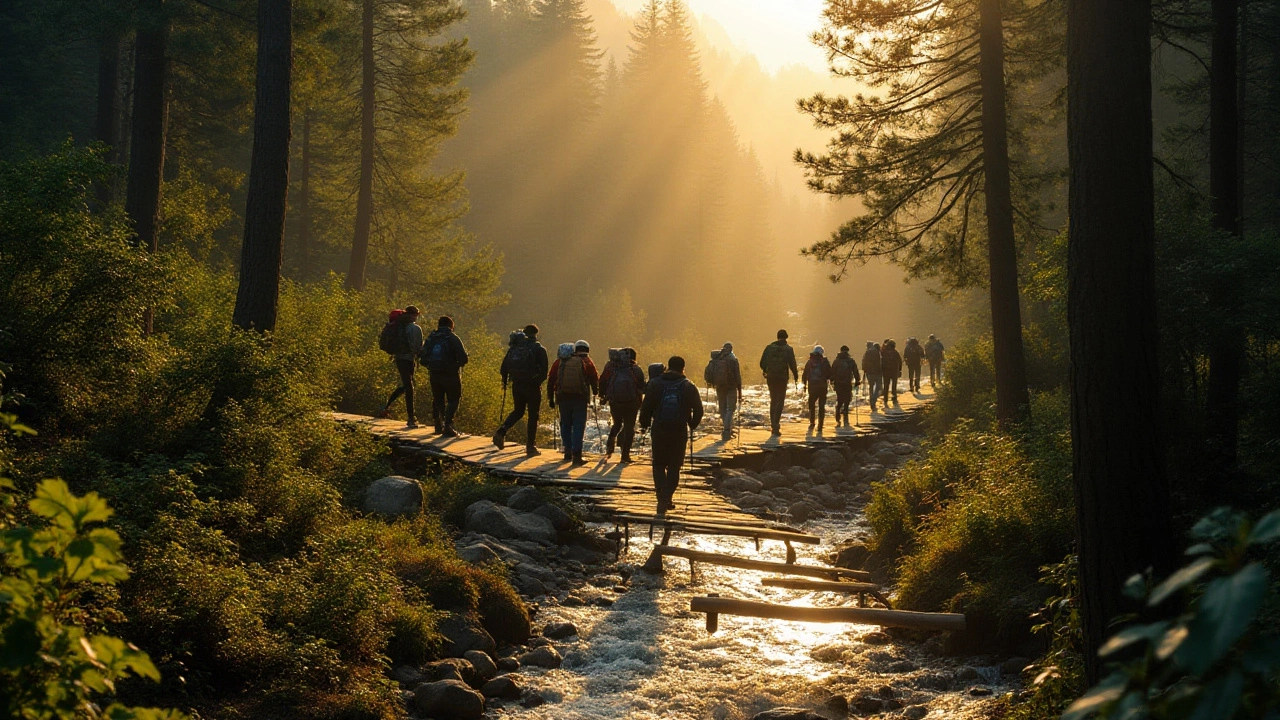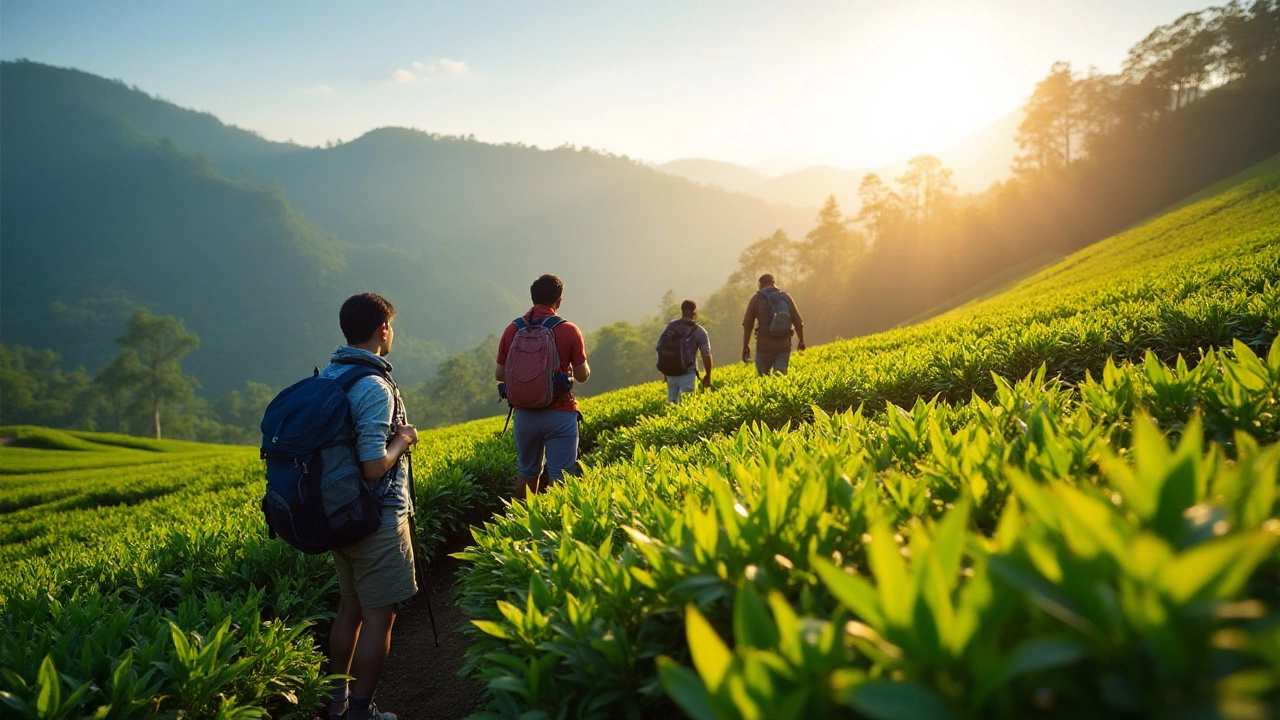Embarking on a hike in the vast and varied landscapes of India opens a gateway to understanding nature in its rawest form. Whether you're traversing the pristine beauty of the Western Ghats or the imposing terrains of the Himalayas, knowing how far a two-hour hike might take you is key to planning your trekking adventure.
The hiking pace, a blend of personal fitness and trail conditions, plays a significant role in determining the distance covered. On average, a moderate pace on a flat trail might see you cover around 3 to 4 miles per hour, but this varies greatly with elevation and difficulty.
India's trekking trails are as diverse as they are plentiful, each offering unique conditions and experiences. From the verdant paths of Munnar to the daunting heights of Uttarakhand, these trails invite both the novice and seasoned hiker to explore their depths.
- Understanding Hiking Pace
- Factors Affecting Hiking Distance
- Popular Indian Trekking Trails
- Safety and Preparation Tips
- Recommended Hiking Gears
Understanding Hiking Pace
Every hiker's journey is uniquely personal, as the pace at which one covers ground during a hike depends on myriad factors, ranging from personal fitness levels to the nature of the trail itself. When planning a hiking in India expedition, it is essential to understand what hiking pace entails and how it influences the overall experience. A moderate hiking pace usually averages between 2 to 3 miles per hour on flat, uncomplicated terrains, but there are nuances to consider that greatly affect this estimate. Elevation gain, the technicality of the path, weather conditions, and the hiker's own vitality all play pivotal roles.
The degree of elevation profoundly impacts hiking speed. An ascent is naturally more demanding, slowing down even the most experienced hikers. For instance, climbing a steep slope can reduce one's pace to as little as a mile an hour, requiring more frequent breaks and a greater expenditure of energy. Conversely, when descending, caution often tempers speed. Whether navigating the slick roots of the Himalayan trails or the rugged paths in the Western Ghats, each variation in the trail demands a quick shift in approach.
The individual's conditioning and acclimatization to high altitudes, encountered often in popular Indian trekking spots like Uttarakhand, are crucial. A hiker well-acclimatized to altitude will naturally maintain a more consistent pace than someone who isn't. However, a hike's exertion is not limited to physiology. Psychological factors, such as a hiker's mental stamina and familiarity with trail environments, can influence pace by dictating how often they pause to relish their surroundings or complete a particularly arduous segment.
Susan Alcorn, an experienced long-distance hiker, remarked, "Hiking is not just about how fast you can go but how much you can enjoy the beauty at your own rhythm. Each step is part of the journey."
Different hiking speeds during multi-day treks also require varying levels of stamina and supplies, each demanding an adjustment in pacing. Understanding whether you can tackle the trail with a briskly sustained momentum or need rest periods for acclimatization will make all the difference in maintaining energy levels and avoiding fatigue. Additionally, cooperative forces like group dynamics can introduce pacing challenges. In group hikes, a standard pace is often established to accommodate different skill levels, enhancing the collective experience by ensuring no participant is left behind while maintaining a reasonable pace for everyone.
The elements often add another unpredictable layer to hiking. Winds, rain, or sudden fog can quickly alter a hiker's tempo, demanding adaptability and an intuitive reclining personal body tempo. The unexpected might provoke a more responsive pace, characterized by short bursts of energy to traverse rapidly changing conditions. For those traversing trails in India's monsoon-blessed regions, like the lush greenery of the Western Ghats, these considerations are top of mind.
Encapsulating these nuances, it's clear that a hiker's pace is a mesh of predispositions and decisions, letting them harmonize with the terrain, their body, and companions. A meditative side of hiking emerges with the understanding of pace; it is about immersing in nature, attuning to personal physical cadence, and finding harmony with the environment. Thus, understanding and refining your hiking pace enriches every aspect of your trekking adventure.
Factors Affecting Hiking Distance
When planning a hiking in India journey, several variables come into play influencing the distance you might cover during a two-hour hike. The landscape is painted with diverse terrains, each offering its own set of challenges. To begin with, the nature of the trail itself significantly impacts your hiking distance. Trails can vary from steep and rugged mountain paths, such as those in the Himalayan ranges, to more gentle inclines found in regions like the Aravalli hills. Elevation gain is a major culprit in reducing hiking speed; for every 1,000 feet of elevation climbed, it's common to lose about 30 minutes of pace. So, if you're hiking up the enchanting but steep slopes of the Sahyadris, be mindful of how much time an uphill journey consumes compared to a flat terrain hike.
Weather conditions are another key factor to consider. The extremes of India's climate, from monsoon downpours to sweltering heat, can affect not just your comfort but also your performance. High humidity can tire you out faster, while rain can make paths slippery, requiring more careful and slower navigation. This is particularly true for trekking trails near coastal regions like Goa where slippery red soil can become a challenging adversary during rains. Interestingly, a survey by the Indian Meteorological Department reveals that areas in the Northeast such as Meghalaya receive the highest rainfall, impacting hiking conditions heavily. Hikers in these regions might find their distances drastically reduced due to more frequent stops and slower movements.
Another factor that determines how far you might venture is your own physical condition and hiking experience. Seasoned hikers might stride confidently over rough terrains, maintaining speed and stamina. In contrast, beginners may find themselves needing more breaks and thus covering shorter distances. Establishing a comfortable pace that allows enjoyment of the scenery while maintaining a steady movement is important. Fitness not only involves stamina but also the ability to carry a backpack effectively. This is where knowing how to pack wisely, keeping essentials without overburdening yourself, can make a difference. According to hiking enthusiasts, reducing backpack weight by just 1 kilogram increases typical hiking distance by about 5% – a handy tip when setting out on prolonged excursions.
Lastly, let's not forget the role of trail connectivity and markers on the routes you choose. Well-marked trails, like those of the popular Valley of Flowers in Uttarakhand, ensure you don't waste valuable time looking for directions. A study by the Himalayan Hiking Association found that unmarked trails can slow a hiker by up to an hour in dense forested areas, highlighting the importance of good trail guidance. Attention to maps or using reliable GPS services can ease such worries, ensuring that you make the most of your hiking timeframe in terms of distance.
"The world reveals its beauty to those who travel on foot," an old saying by Werner Herzog serves as a reminder that while the journey may vary in distance, each step uncovers unique beauty and experiences that enrich the soul.

Popular Indian Trekking Trails
India, a country known for its rich tapestry of landscapes, offers some of the world's most exhilarating trekking experiences. Each region boasts trails that cater to diverse interests, from serene walks through lush forests to adrenaline-pumping ascents into the snowy Himalayas. One of the most sought-after treks is the Chadar Trek on the frozen Zanskar River in Ladakh, where trekkers face freezing temperatures but are rewarded with stunning views of ice formations and ancient monasteries. It's an adventure that challenges both the body and the spirit, emphasizing why India remains a top destination for trekking enthusiasts worldwide.
In the southern part of India, the Kumara Parvatha trek in Karnataka offers a different kind of challenge. This trail is famous for its verdant surroundings and diverse flora and fauna. It winds through the Western Ghats, a UNESCO World Heritage site, and requires a decent level of fitness and endurance. On the trail, trekkers may encounter exotic bird species such as the Malabar parakeet and, if fortunate, spot elephants wandering in their natural habitat. Such experiences highlight the ecological significance of these trekking routes.
Another popular trail is the Valley of Flowers trek in Uttarakhand. It's renowned for its impressive array of unique alpine flowers and is a breathtaking spectacle during the monsoon months. The valley was declared a national park and later became a UNESCO World Heritage site, ensuring its conservation. Trekkers often note the surprising contrast between the intense ascents to reach this paradise and the picturesque, serene landscapes upon arrival.
"The Valley of Flowers is not just a trek; it's a journey into a world where nature's riot of colors paints the soul," says veteran trekker and author, Rupinder Kaur.
For those seeking a trek closer to cultural and historical significance, the Kheerganga Trek in Himachal Pradesh is exemplary. This trek takes you through the mystical landscapes of Parvati Valley to the hot springs at Kheerganga, known for their therapeutic properties. The journey is interspersed with narratives of ancient myths and stories passed down through generations, making it a cultural exploration as much as a physical one. The region's rustic villages offer insights into local traditions and lifestyles, adding rich layers to the trekking experience.
To aid in your decision-making process, here's a useful comparison of some popular trekking trails in India:
| Trail Name | Region | Difficulty Level | Best Months to Visit |
|---|---|---|---|
| Chadar Trek | Ladakh | Moderate to Tough | January to February |
| Kumara Parvatha | Karnataka | Moderate | October to January |
| Valley of Flowers | Uttarakhand | Easy to Moderate | July to September |
| Kheerganga Trek | Himachal Pradesh | Easy | May to November |
Each trail listed not only provides opportunity for adventure and exploration, but also allows trekkers to engage deeply with nature's beauty and the cultural richness of India.
Safety and Preparation Tips
Embarking on a hiking adventure in the vast trekking trails of India requires thorough preparation to ensure safety. The unpredictable weather conditions, varied terrains, and possible wildlife encounters mean that one must not only be physically prepared but mentally equipped to handle unforeseen circumstances. Understanding the terrain you plan to traverse is the first critical step. This involves familiarizing yourself with the specific trail conditions, elevation changes, and any potential hazards along the way. Many trails in India, such as those in the Himalayas, can quickly shift from well-trodden paths to challenging mountain routes, demanding a good level of fitness and agility.
Choosing the right gear can make a significant difference in your trekking experience. Ensuring you have sturdy hiking boots is crucial as they provide the necessary support and protection against rocky surfaces and slippery areas. A good quality backpack that evenly distributes weight can help prevent strain and fatigue. It's excellent to pack light but make sure to include essentials like a first aid kit, sufficient water to stay hydrated, and energy-rich snacks to keep your energy levels up. Don't underestimate the importance of layered clothing, either. Conditions can vary greatly, especially in regions with significant altitude changes, so it's best to be prepared for both sun and harsh cold.
Navigation is another vital aspect of your preparation. While many popular trails have marked paths, it’s always prudent to carry a physical map or a fully charged GPS device. Modern advancements like apps specifically designed for hikers can also help track your route, ensuring you don't venture off the beaten path. Safety consideration also involves staying connected, either through a mobile phone or a satellite communicator, especially in remote areas where mobile reception might be unreliable. Many trekking trails in India are accessible to beginners but don’t assume that all are equally safe, as some require permits or guides.
Let's not forget the importance of understanding the local wildlife. Many hiking in India opportunities bring you into close proximity with nature, sometimes including wild animals. It's vital to know the kind of wildlife in the area and how to respond to potential encounters without harming the ecosystem. To quote the Himalayan Mountaineering Institute, "Respect for nature involves preparedness and precaution, vital to enjoying the untouched beauty while ensuring our own safety."
Lastly, factor in adequate rest and acclimatization, especially for higher altitude treks. Knowing your limits and allowing your body to adjust is an essential part of the experience. With so many outdoor adventures awaiting, proper preparation allows you to make the most of the trails while ensuring a safe and memorable journey.

Recommended Hiking Gears
Venturing into the world of trekking, particularly in the diverse landscapes of India, requires equipping oneself with the right gear for both safety and comfort. A successful hiking experience heavily relies on the gear you carry, ensuring your trek is both enjoyable and secure. Each piece of equipment serves a crucial purpose, catering to the demanding conditions of trails that range from humid forests to cold mountain paths. Selecting suitable hiking gear involves considering the terrain, weather conditions, and duration of your hiking in India adventure.
Begin with the basics: choosing the right footwear. This is essential, as the terrain can greatly impact your overall experience. While trails in places like the Himachal Pradesh may require sturdy, ankle-supporting boots, the flatter regions like Kerala might only need comfortable walking trainers. A well-fitted pair of hiking boots not only provides grip and protection but also helps prevent blisters and fatigue over long distances.
Another indispensable item in your hiking arsenal is a high-quality backpack. When selecting a backpack, aim for one with a supportive frame and ergonomic design that minimizes strain on your shoulders and back. Water and hydration systems, often integrated into the backpack, are lifelines on trekking trails. Carrying enough water is critical, particularly on longer treks where refilling stations are scarce. Always ensure you have ample storage for food, clothing, and emergency supplies, as changing weather conditions can necessitate quick adjustments.
Clothing Layering System
Opting for a clothing layering system is vital. This allows you to add or remove clothing according to changes in weather and activity levels. Wool or synthetic base layers wick moisture away from your skin, keeping you warm in cooler climates and dry in more humid environments. Mid-layers offer insulation, while outer layers should be waterproof and windproof, ideally with breathable fabric. The unpredictable weather of Indian trails, especially in trekking trails around Manali, requires adaptable clothing to handle potential rain or sudden drops in temperature.
"There’s no such thing as bad weather, only inappropriate clothing." – Sir Ranulph Fiennes, British explorer.
Finally, the value of navigation tools cannot be overstated. Whether it's a traditional map and compass or a GPS device, knowing your position on the outdoor adventures is crucial for safety. Ensure your map is accurate, detailed, and covers the entire area of your trek. A sturdy compass can be just as important, especially when technology fails. On more popular hiking routes, you may find well-marked trails, but having backup navigation ensures peace of mind, keeping you oriented and confident as you bask in the beauty of India's stunning natural vistas.
